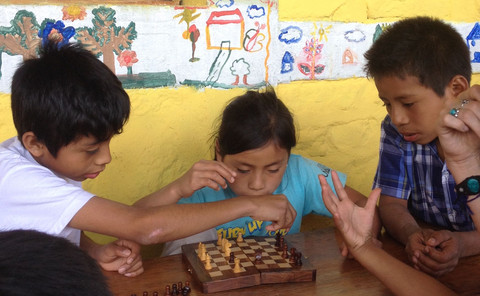Last month marked the one-year anniversary of Konojel‘s Children’s Education program. Konojel began 4 years ago as a lunch program for mothers and children who are the most at risk of acute and mal-nutrition. Last year, the lunch program grew to include a Children’s Education Program for the beneficiary children. After lunch, approximately 30 children stay for an hour for support in reading, writing, math, and to play in ways that support their personal and academic development.

The program got a boost this January, when Konojel and JUSTA teamed up to co-fund a major step in its development. Konojel received an education grant, and JUSTA matched the funding of the Children’s Education Program. This was enough support to hire two indigenous women from the community of San Marcos and me, Jackie Mauer.

I have about 10 years of teaching experience – working in schools in Wisconsin and on education-oriented projects in four countries. I hold a professional masters degree in French and International Development. Before coming to Guatemala to work coordinate this program for Konojel and JUSTA, my Spanish was limited as was my experience in Central America.

Laura, our first educational assistant (far right), is an 18-year-old woman from San Marcos. She has a middle school degree and cares for her diabetic mother while she is not at Konojel. She is trying to find a way to earn a high school degree, but money and cultural expectations are obstacles.
Vicenta (far left), our second educational assistant, is also from San Marcos and is working on her middle school degree in night school. She is a single mother with three daughters; two of her daughters go to a Waldorf school in town. Vicenta is an eager participant of Konojel’s adult-oriented nutrition workshops and the Waldorf school’s parent workshops.
The members of our team come from very different societies and have very different culturally-formed ideas about what childhood and education mean. In my hometown, kids go to school for 8 hours and then hop from ballet to soccer to karate classes. In San Marcos, many people as young as 6 are out doing odd jobs carrying wood or splitting rocks to buy their own food; school means a drop in income. Schools also operate very differently in our two countries with different learning objectives.

With such different cultural backgrounds and social realities, how can we agree on what the kids need? How does our team make decisions?
We skipped some tough conversations and let the kids show us what to do.
We observed that children were more engaged in activities that they had chosen themselves. So we give them choice. Children can choose activities such as reading for fun, tackling visual-spatial puzzles, researching topics of interest, and trying creative art and craft projects.
We observed that children were more likely to absorb information while interacting one-on-one with the adults (rather than in the whole group), so we provide activities that kids can do independently and float around to deliver personalized support.
We observed that children display more interest in practicing math skills when they are playing a game than when they were doing a worksheet. So we made and acquired math games and intervention tools to develop different skills in the Guatemalan curriculum.

Laura, Vicenta, and I do sometimes have differing opinions about how an activity should run or what to prioritize, and these ideas are deeply rooted in our very different notions of childhood and education and our different cultural experiences.
This is the tricky part about multi-cultural/diverse teams – everyone is right. We can’t debate an idea and expect to change the other person’s mind. So when differing ideas come up, we skip the debate and just try one – then discuss. Our discussions are then based on our shared experiences and nourished by our different backgrounds. If we see positive attitudes and participation when we try something, the idea takes hold and finds a place in our co-constructed values and philosophy.
As Laura, Vicenta, and I grow in our understanding of how to support the children in our program, the children also grow. Over the past few months we’ve seen more smiles, more curiosity for learning, and more cooperation and kindness. Many of our children do not have adults in their lives to care for them and on whom they can rely. Slowly, the children of Konojel are adapting to an environment where they are free and safe to just be kids.

